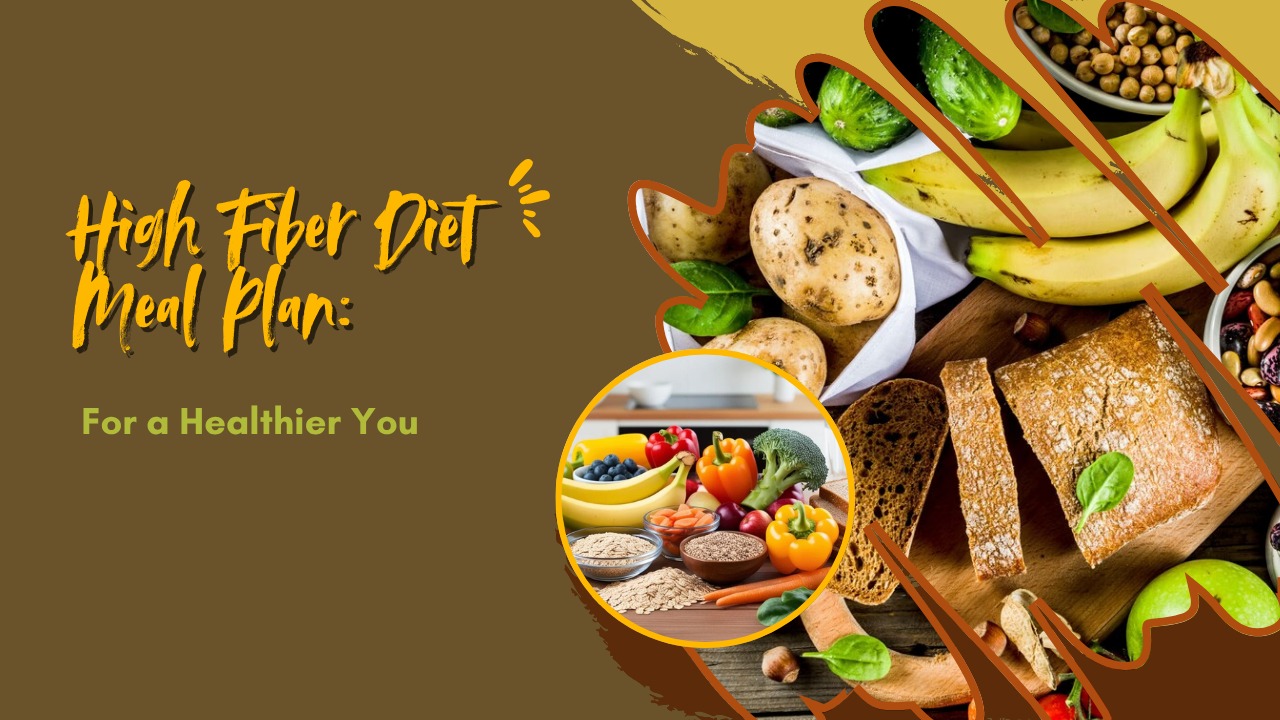A high fiber diet meal plan emphasizes the intake of fiber-rich foods such as fruits, vegetables, legumes, whole grains, and nuts. Unlike other carbohydrates, dietary fiber isn’t digested by the body. Instead, it moves through the digestive system, helping to regulate bowel movements and remove waste efficiently.
Following a high fiber diet meal plan is especially important in today’s world of overly processed, low-nutrient foods. Fiber does more than aid digestion—it helps reduce the risk of serious health conditions like type 2 diabetes, heart disease, colon cancer, and even obesity. This makes it an essential part of long-term wellness.
Additionally, fiber-rich meals help you feel full for longer, which naturally reduces overeating and supports healthy weight management. Whether you’re looking to improve your gut health, manage your weight, or prevent chronic disease, a high fiber diet meal plan offers a simple, sustainable solution with lasting benefits.
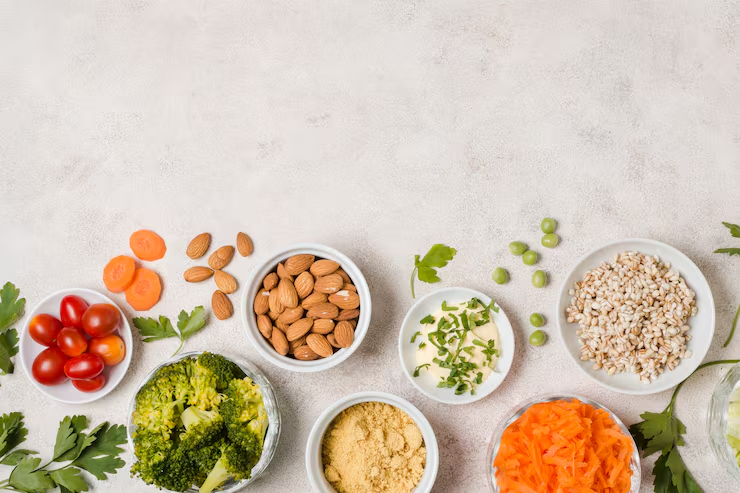
What Does a High Fiber Diet Consist Of ?
A high fiber diet meal plan focuses on foods that are naturally rich in dietary fiber—mainly plant-based ingredients. These include fruits, vegetables, whole grains, legumes, nuts, and seeds. Fiber comes in two types: soluble (which dissolves in water and helps lower blood sugar and cholesterol) and insoluble (which adds bulk to the stool and aids digestion).
To build an effective high fiber diet meal plan, start with a fiber-packed breakfast like oatmeal with berries or whole grain toast with avocado. At lunch and dinner, load your plate with beans, lentils, brown rice, quinoa, leafy greens, and colorful vegetables. Don’t forget to snack smart with fruits, raw veggies, or nuts.
By incorporating a wide range of fiber sources throughout the day, your high fiber diet meal plan can support gut health, improve satiety, manage blood sugar levels, and reduce your risk of chronic diseases. Consistency is key to results.
A high fiber diet includes:
Whole grains (brown rice, oats, barley)
Legumes (lentils, black beans, chickpeas)
Fruits (apples, pears, berries)
Vegetables (broccoli, carrots, spinach)
Nuts and seeds (chia, flax, almonds)
Daily recommended intake of fiber:
Men under 50: 38 grams
Women under 50: 25 grams
Men over 50: 30 grams
Women over 50: 21 grams
Why Is a High Fiber Diet Important ?
A high fiber diet meal plan plays a vital role in maintaining digestive health and overall wellness. Fiber helps regulate bowel movements, preventing constipation and promoting a healthy gut microbiome. It keeps your digestive system running smoothly and reduces the risk of gastrointestinal issues.
Beyond digestion, a high fiber diet meal plan supports heart health by helping lower cholesterol levels and blood pressure. Soluble fiber, in particular, binds to cholesterol and aids in its elimination from the body. It also helps stabilize blood sugar levels, making it especially beneficial for people with diabetes or those at risk.
Incorporating fiber-rich foods into your daily routine can also support weight management. Fiber increases feelings of fullness, helping reduce overall calorie intake. Whether your goal is to improve health or prevent disease, a consistent high fiber diet meal plan can offer lasting benefits and is a key part of a balanced lifestyle.
The benefits of a fiber-rich meal plan extend beyond the bathroom:
Digestive Health: Prevents constipation and promotes bowel regularity.
Weight Management: Helps control appetite and reduces overeating.
Heart Health: Lowers cholesterol and improves blood pressure.
Blood Sugar Control: Slows sugar absorption to manage insulin levels.
Cancer Prevention: Linked with lower risks of colon and breast cancer.
When Should You Start a High Fiber Diet ?
The best time to embrace a high fiber diet meal plan is now. Adding more fiber to your meals can significantly boost your digestive health and overall well-being. However, diving in too quickly can lead to bloating, gas, or stomach discomfort.
To avoid these side effects, introduce fiber slowly. Begin by incorporating just one high-fiber food each day—like oatmeal for breakfast or lentils for lunch. This gradual approach helps your digestive system adjust and reduces the risk of any discomfort.
Don’t forget the importance of hydration. As you increase your fiber intake, drink plenty of water to help fiber move smoothly through your digestive tract. By making small, manageable changes and staying consistent, your body will soon adapt. Before long, your high fiber diet meal plan will feel natural and rewarding, with benefits that include better digestion, increased energy, and long-term health support.
How Does a High Fiber Diet Work ?
A high fiber diet meal plan works by supporting your digestive system through increased intake of plant-based fiber found in fruits, vegetables, legumes, and whole grains. Unlike other carbohydrates, fiber isn’t digested or absorbed—it passes through your system, helping to regulate bowel movements and cleanse your digestive tract.
Soluble fiber, found in foods like oats and beans, absorbs water and forms a gel-like substance that slows digestion, helping to control blood sugar levels and lower cholesterol. Insoluble fiber, present in whole wheat and vegetables, adds bulk to the stool and prevents constipation by speeding up the passage of food.
Together, these types of fiber promote satiety, meaning you feel full longer, which is essential for weight management. Following a high fiber diet meal plan consistently can reduce the risk of chronic diseases such as diabetes, heart disease, and colon cancer—while also keeping your energy levels steady throughout the day.
Fiber adds bulk to your stool and promotes the movement of material through your digestive system. There are two types of fiber:
Soluble Fiber: Dissolves in water to form a gel-like material. Found in oats, apples, and legumes.
Insoluble Fiber: Adds bulk to stool and helps food pass more quickly. Found in whole grains and vegetables.
Together, these fibers support a well-functioning gut and provide long-term health protection.
Top Tips for an Effective High Fiber Diet Meal Plan
Start Your Day with Whole Grains
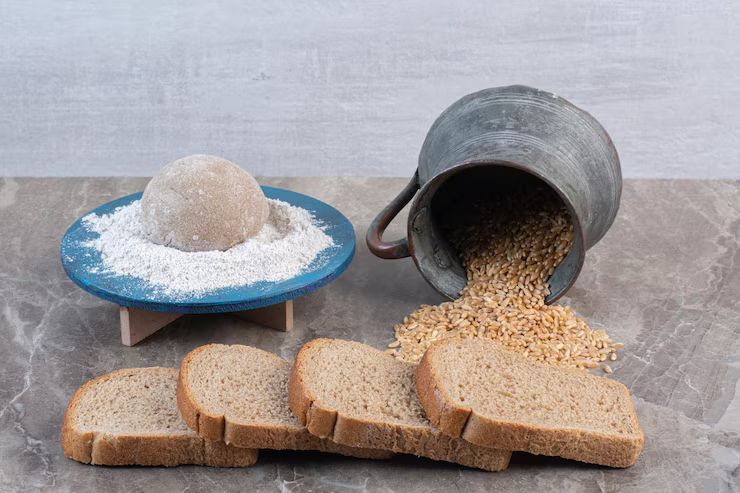
A smart high fiber diet meal plan begins with breakfast, and whole grains are the perfect way to fuel your morning. Options like oatmeal, whole grain toast, or quinoa porridge are rich in dietary fiber that promotes digestive health and helps keep you full for longer periods.
Including whole grains in the morning helps regulate blood sugar levels and prevents energy crashes later in the day. You can top oatmeal with berries and flaxseeds, or enjoy whole grain toast with avocado for a fiber-packed, nutritious start to the day.
Consistently starting your day with whole grains sets the tone for balanced eating. It’s an easy and delicious way to ensure you’re hitting your daily fiber goals. As part of a well-rounded high fiber diet meal plan, whole grains contribute to better digestion, heart health, and sustained energy throughout the day—making them a breakfast essential.
Tip: Swap your regular breakfast cereal for steel-cut oats, bran flakes, or quinoa.
Benefit: Whole grains provide sustained energy and keep you full.
Ingredients: Rolled oats, almond milk, chia seeds, banana slices.
Meal Idea: Oatmeal bowl with nuts and berries.
Add Legumes to Your Lunch
Incorporating legumes into your lunch is a simple and effective way to boost your fiber intake. Beans, lentils, chickpeas, and peas are all fiber-rich superfoods that add substance and flavor to your meals. Whether tossed in a salad or blended into a soup, legumes support a healthy digestive system and provide lasting energy.
A well-balanced high fiber diet meal plan often includes lentil soups, chickpea wraps, or black bean bowls during lunchtime. These options are not only high in fiber but also packed with protein and essential nutrients, making them a great choice for vegetarians and meat-eaters alike.
Adding legumes to your midday meal helps you feel full longer, reduces blood sugar spikes, and supports overall gut health. It’s an easy, affordable, and delicious habit that can transform your high fiber diet meal plan into a truly nourishing experience—one bite at a time.
Tip: Include chickpeas, lentils, or black beans in salads or soups.
Benefit: High in both fiber and protein—great for vegetarians.
Ingredients: Mixed greens, red kidney beans, olive oil, lemon juice.
Meal Idea: Lentil soup with whole-grain bread.
Snack Smart with Fruits and Nuts
Snacking doesn’t have to derail your healthy eating goals. In fact, choosing fiber-rich options like fruits and nuts can help keep your energy up and hunger at bay. Apples, pears, bananas, and berries are great sources of fiber and natural sweetness. Pair them with almonds, walnuts, or pistachios for a satisfying, nutrient-dense snack.
In a well-rounded high fiber diet meal plan, smart snacking plays a crucial role. Instead of reaching for processed chips or sugary treats, a handful of dried apricots with cashews or carrot sticks with hummus can add valuable fiber and keep your metabolism steady between meals.
These small changes can make a big difference. By incorporating fiber-packed snacks into your routine, you’re supporting better digestion, balanced blood sugar, and long-lasting fullness. Make fruits and nuts a daily part of your high fiber diet meal plan, and enjoy both flavor and function in every bite.
Tip: Choose snacks like an apple with almond butter or a handful of mixed nuts.
Benefit: Boosts energy and aids digestion.
Ingredients: Apple, peanut butter, walnuts, raisins.
Meal Idea: Sliced pear topped with Greek yogurt and granola.
Eat More Vegetables—Raw and Cooked
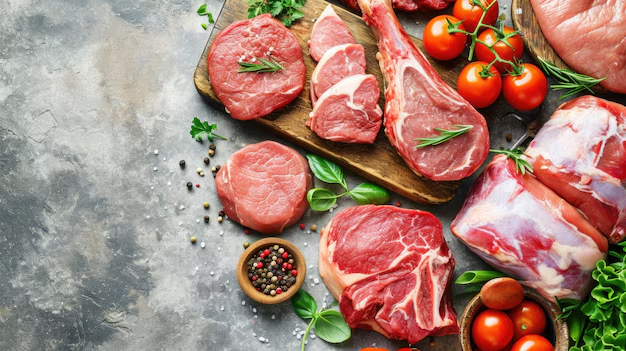
Vegetables are one of the easiest and most effective ways to boost your fiber intake. Whether you enjoy them raw in salads or cooked in stir-fries, soups, or roasts, they provide essential nutrients and bulk to your meals. Leafy greens like spinach and kale, cruciferous veggies like broccoli and cauliflower, and root vegetables like carrots and beets are all fiber champions.
Including a wide variety of vegetables in your high fiber diet meal plan helps support digestion, weight control, and heart health. Raw veggies retain their full fiber content, while cooked ones can be easier to digest, offering a good balance when enjoyed together.
To stay on track, aim to fill half your plate with colorful vegetables at lunch and dinner. Whether steamed, grilled, blended into smoothies, or eaten fresh, vegetables are a non-negotiable part of a successful high fiber diet meal plan that nourishes and satisfies.
Tip: Aim to fill half your plate with vegetables at every meal.
Benefit: Low in calories, high in fiber, and packed with nutrients.
Ingredients: Broccoli, carrots, kale, olive oil, garlic.
Meal Idea: Stir-fried mixed vegetables with brown rice.
Include Chia and Flax Seeds in Your Diet
Chia and flax seeds are tiny nutritional powerhouses packed with fiber, omega-3 fatty acids, and antioxidants. Just a tablespoon of these seeds can significantly boost your daily fiber intake. Chia seeds swell when soaked, making them perfect for puddings, smoothies, and yogurt toppings. Flax seeds, especially when ground, are easy to mix into oatmeal, baked goods, or salad dressings.
Adding these seeds to your high fiber diet meal plan is a smart and effortless way to enhance overall health. Their soluble fiber helps regulate blood sugar, support digestive health, and promote satiety—ideal for weight management.
To maximize their benefits, incorporate chia and flax seeds daily into your meals and snacks. Whether you sprinkle them on breakfast or blend them into drinks, they’re a convenient addition to any high fiber diet meal plan and a simple step toward meeting your fiber goals with ease and flavor.
Tip: Sprinkle chia or flax seeds over smoothies, salads, or yogurt.
Benefit: High in omega-3 fatty acids and fiber.
Ingredients: Chia seeds, soy milk, strawberries, banana.
Meal Idea: Chia pudding with berries and coconut.
Choose Whole Over Refined Products
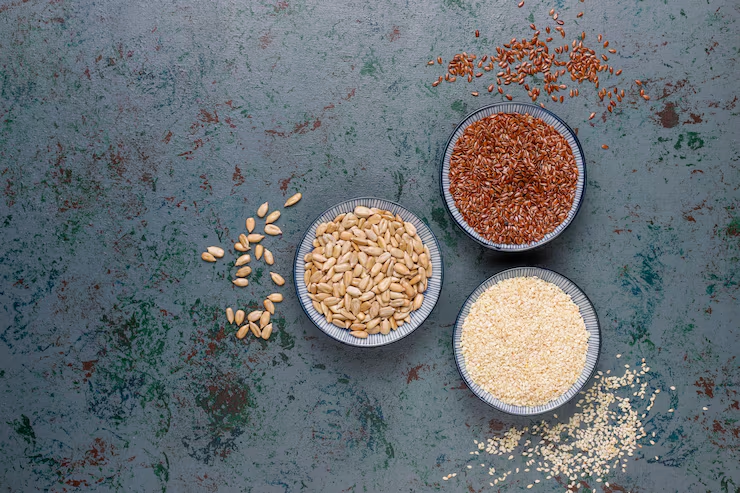
One of the easiest ways to boost your fiber intake is by choosing whole over refined products. Whole grains like brown rice, quinoa, whole wheat bread, and oats retain their bran and germ, which are rich in fiber and essential nutrients. In contrast, refined grains are stripped of these parts, losing much of their nutritional value.
Incorporating whole grains into your high fiber diet meal plan not only supports digestive health but also helps stabilize blood sugar levels and reduce the risk of chronic diseases like heart disease and type 2 diabetes. Plus, whole grains provide lasting energy and keep you full longer.
To get the most out of your high fiber diet meal plan, start by swapping out white rice, white bread, and regular pasta for whole grain alternatives. These small changes can make a big difference in your daily fiber intake and contribute to long-term health and wellness.
Tip: Replace white bread, pasta, and rice with whole grain versions.
Benefit: Enhances satiety and stabilizes blood sugar.
Ingredients: Whole grain pasta, tomato sauce, zucchini.
Meal Idea: Whole wheat pasta primavera.
Drink Plenty of Water

Staying hydrated is essential when following a high fiber diet meal plan. Fiber works best when it absorbs water, helping to add bulk and softness to your stool for easier digestion. Without enough fluids, high fiber foods can actually cause or worsen constipation, defeating the purpose of a fiber-rich diet.
When you increase your fiber intake, you must also increase your water consumption. Aim to drink at least 8 glasses of water per day, and even more if you’re very active or live in a hot climate. Herbal teas, infused water, and water-rich foods like cucumbers and watermelon also count toward your fluid intake.
Hydration and fiber go hand-in-hand. A well-balanced high fiber diet meal plan that includes plenty of water will support healthy digestion, help flush toxins from the body, and ensure that your new eating habits are both effective and comfortable for your digestive system.
Tip: Stay hydrated to help fiber do its job.
Benefit: Prevents constipation and keeps your digestive tract healthy.
Suggestion: Aim for at least 8 glasses of water per day.
Pro Tip: Infuse with lemon or mint for flavor without calories.
Plan Ahead with a Weekly Fiber Meal Prep
Sticking to a high fiber diet meal plan becomes much easier when you prepare in advance. Meal prepping saves time, reduces daily stress, and ensures you’re always equipped with nutrient-rich, fiber-filled options. By planning your week ahead, you avoid last-minute choices that often lead to low-fiber, processed foods.
Start by choosing a few fiber-rich staples like lentils, quinoa, roasted vegetables, and whole grain wraps. Batch-cook them and store in containers for grab-and-go meals. Pre-washed greens, chopped fruits, and portioned snacks like almonds or trail mix also make it convenient to stay on track.
With a solid high fiber diet meal plan, weekly prep ensures you get a balanced intake of fruits, vegetables, legumes, and whole grains without the hassle. It helps you stay consistent, supports digestion, and makes healthy eating part of your daily routine—saving both time and your health in the long run.
Tip: Prepare meals in advance to ensure consistent fiber intake.
Benefit: Saves time, supports consistency, and prevents poor choices.
Meal Plan Example:
Monday: Quinoa bowl with chickpeas and veggies
Tuesday: Black bean tacos with cabbage slaw
Wednesday: Barley soup with whole grain roll
Thursday: Brown rice stir-fry with tofu
Friday: Veggie-loaded chili with cornbread
Saturday: Spinach lentil salad with whole wheat pita
Sunday: Oats with banana and almond butter
Sample High Fiber Diet Meal Plan (Daily Breakdown)
Here is your high fiber diet meal plan presented in a clear table format:
| Meal | Menu | Fiber Source Highlights |
|---|---|---|
| Breakfast | Oatmeal with berries and flaxseedsGlass of almond milk | Oats, berries, flaxseeds, almond milk |
| Snack | Apple with peanut butter | Apple skin, natural peanut butter |
| Lunch | Lentil soupWhole grain breadCucumber and tomato salad | Lentils, whole grains, fresh veggies |
| Snack | Handful of almonds and dried apricots | Almonds, dried fruits |
| Dinner | Grilled vegetablesBrown riceTofu or chickpeas | Vegetables, brown rice, legumes (tofu/chickpeas) |
| Dessert | Chia seed pudding with blueberries | Chia seeds, blueberries |
| Total Fiber | Approx. 35–40 grams |
This high fiber diet meal plan delivers balanced nutrition while supporting digestive health and overall well-being.
Conclusion
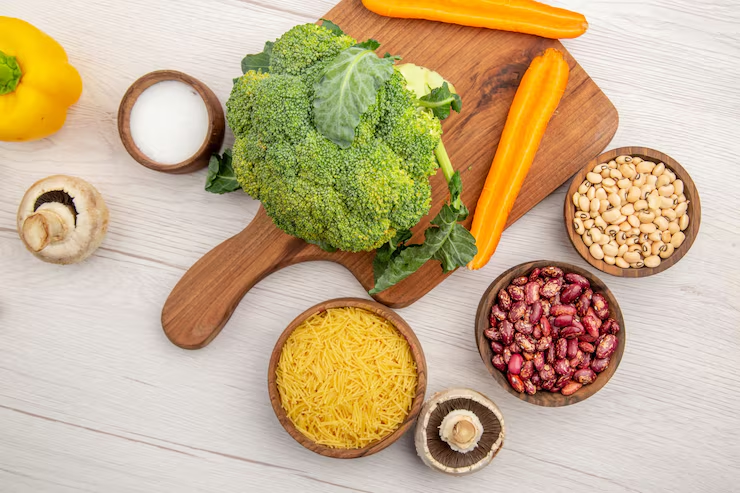
A high fiber diet meal plan isn’t just a health fad—it’s a smart, sustainable approach to eating that supports long-term wellness. Backed by science, fiber-rich diets help manage weight, regulate digestion, and lower the risk of chronic diseases like heart disease, diabetes, and certain cancers.
With a little planning, it’s easy to transform your daily meals into fiber-packed fuel. Simple swaps—like choosing whole grains instead of refined ones, adding legumes to your soups and salads, or tossing flaxseeds into your smoothies—can dramatically boost your daily fiber intake.
Start integrating a high fiber diet meal plan today. Replace sugary snacks with nuts or fruit, experiment with lentil-based dishes, and remember to drink plenty of water to aid fiber’s digestive benefits. Over time, these small changes lead to big results. Your gut, your energy levels, and your future self will thank you for making this healthy shift.
FAQs
Q1. What is a high fiber diet meal plan ?
A high fiber diet meal plan includes foods rich in dietary fiber, such as whole grains, legumes, fruits, vegetables, and seeds. The goal is to meet or exceed the daily recommended fiber intake to improve digestion, weight management, and heart health.
Q2. How much fiber should I consume daily ?
The recommended daily intake varies by age and gender, but most adults should aim for 25–38 grams of fiber per day. Always increase your fiber intake gradually to avoid bloating.
Q3. Can a high fiber diet help with weight loss ?
Yes. A high fiber diet for weight loss works by promoting satiety, reducing overall calorie intake, and helping regulate blood sugar levels. High-fiber foods also take longer to chew, which can help you eat more mindfully.
Q4. What are the side effects of eating too much fiber ?
Eating too much fiber too quickly can cause gas, bloating, and cramps. To avoid this, gradually increase fiber and drink plenty of water. Adjust if you experience discomfort.
Q5. Is it safe to follow a high fiber diet long-term ?
Absolutely. A long-term high fiber diet has been linked with lower risks of chronic diseases, improved gut health, and longevity. Just ensure it’s balanced with adequate protein, healthy fats, and hydration.


